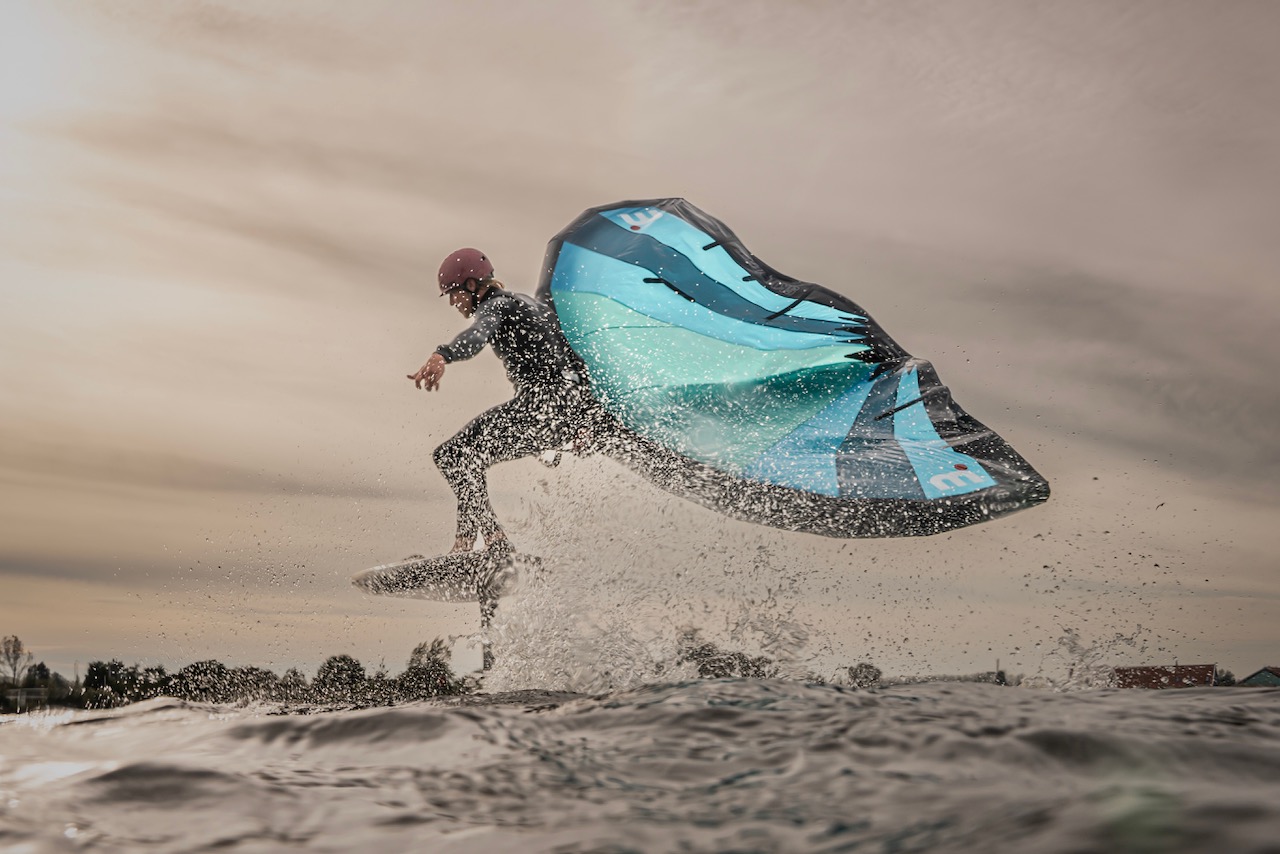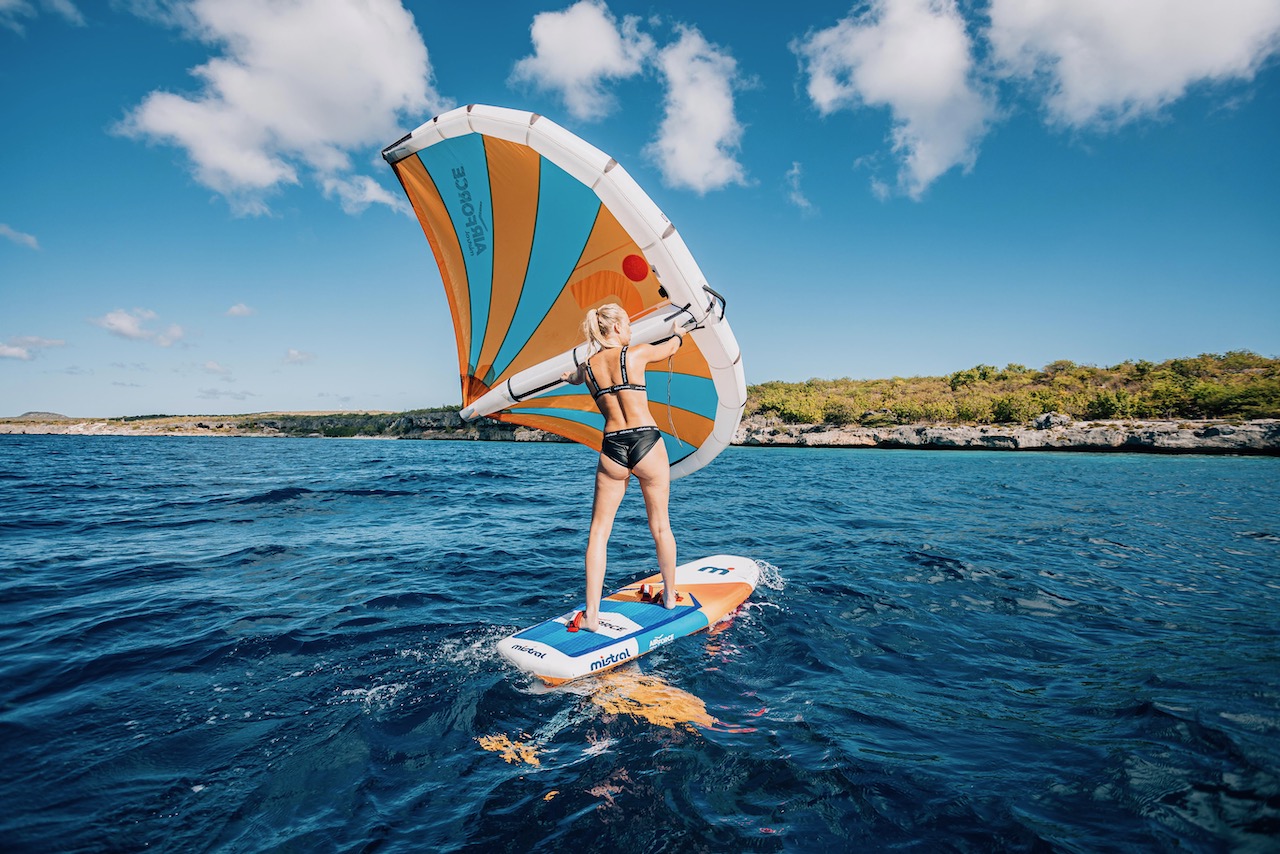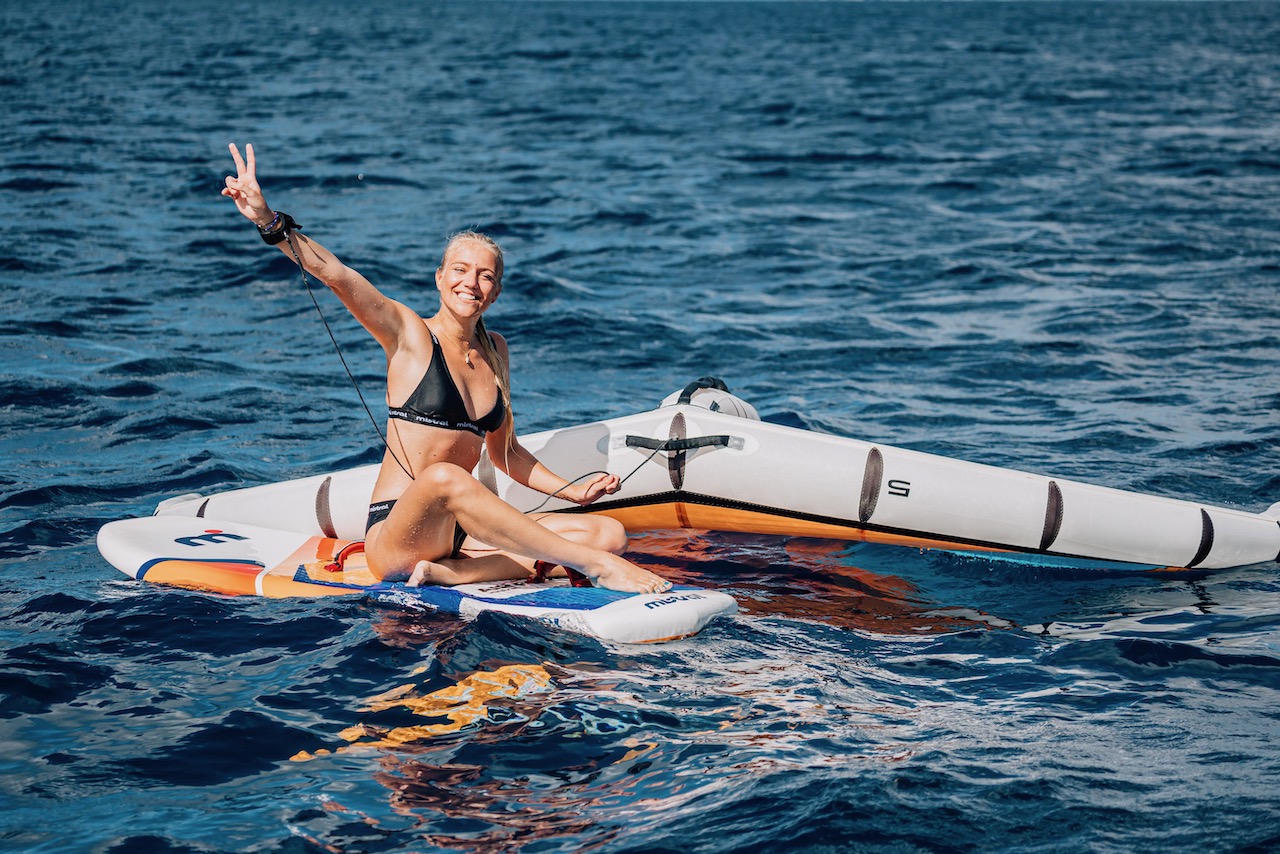Wingfoiling FAQ
6. Juni 2024WHAT IS WINGFOILING
Wingfoiling involves gliding on a hydrofoil board using a lightweight inflatable wing sail for propulsion.
The hydrofoil allows one to fly over water. It combines elements of windsurfing, kitesurfing, and surfing.
The skills are similar to windsurfing, but they are much easier to learn, and the equipment is less bulky and easier to transport.

WHAT DO I NEED IF I WANT TO START WINGFOILING?
Three primary pieces of equipment are needed:
Wing Sail
Hydrofoil (consists of multiple components)
Wingfoil board
HOW MUCH WIND DO I NEED TO WING FOIL
The best wind conditions for learning are between 13 and 22 knots.
As your skills progress with the right gear, you can get foiling in as low as 8 knots of wind and challenge high wind strengths with smaller wing sizes.
HOW LONG DOES IT TAKE TO LEARN
One of the best parts about this sport is the short learning curve.
It is best to learn on a board without a foil, such as on a stand-up paddle board or on one of our boards, which allows for wingsurfing.
With no prior sailing or foiling skills required, you should expect to experience your first sustained foil ride within 3-5 days.
WHAT SIZE WING SHOULD I LEARN WITH
It depends on your local wind conditions and body weight, but a 4.5m - 5m wing can be used in a wide range of wind conditions and has a compact enough wingspan to make learning easier.
IS WING FOILING DIFFICULT
The simple answer is no.
Wing foiling has one of the shortest learning curves of all wind or foil sports.
CAN I FOIL UPWIND
Yes. One of the best things about winging is how efficiently you can get upwind and downwind.
HOW FAST DO THEY TRAVEL?
The average is between 12 and 25 miles per hour. With the right gear, you can reach speeds over 35mph.
HOW CAN I BEGIN TO LEARN? Wingfoiling benefits from being a relatively light wind sport and can be enjoyed in winds above 8 to 10 knots, depending on your body mass.
We recommend learning on either a SUP board or one of our boards designed for wingsurfing, using a wing on a non-foiled board.
This way, you can learn the mechanics and skills for managing the wing before advancing to a foiled board and wingfoiling.
Depending on your pre-existing skill levels, you can opt for use with or without foil.
To make starting from the water easier and getting on the hydrofoil quicker, practice on a fairly windy day.
This will give you the extra power to compensate for the lack of pumping technique required in light wind conditions.
Once your wingsurf skills will get better, you'll be able to glide in low winds.

WHERE TO WINGFOIL IN HOLLAND
If you are a beginner, start on lakes such as Loosdrecht, Ijburg, Aalsmeer, or Almere, where the water is calm.
If you like to surf waves, Wijk aan Zee, Ijmuiden, Scheveningen, or Monster are great places to go when the wind conditions are right.
IS LEARNING DIFFICULT
Learning wingfoiling is easier than you might think, especially if you attend a professional lesson or two.
Because it combines many aspects of other board sports, there’s a chance you will have some experience that will help you learn faster.
The foil is the most foreign element for most people who take a fundamentals lesson.
You can expect first controlled flights within 5-20 hours of practice, but it’s different for everybody.

HOW SAFE IS IT?
There are general safety you need to be aware of, but winging is relatively safe.
You may be intimidated by the foil beneath your feet, but as the wing is your power source, if you ever feel you're losing control, you can simply let go of the wing and glide to a stop.
We always recommend seeking professional lessons if you have concerns about safe practice.
Be sure to wear a helmet and impact vest.
DO I NEED TO BE YOUNG AND STRONG?
Wingfoiling is, in fact, easier on the body than windsurfing or kiteboarding since you are smoothly gliding above the water with minimal resistance instead of planing across the water, absorbing the bumps and chopping through your body.
Wingfoiling requires some balance, provided by the width of the foil's surface area and the board when stationary.
It is not a high-strength sport, as the wind makes the wing light in your hands.
However, taking breaks and playing with powering up and down is easy.
The speeds are also lower and less scary than windsurfing or kitesurfing, and falls are nowhere near as dramatic.
MY CHILDREN WANT TO LEARN
You will know your kids' limitations best; some are really confident on the water and trying new things, while others are more timid.
Children as young as 6-8 are now involved in discovery learning.
The best first contact is using a small wing sail and non-foiled board, progressing to a foil board once windsail control is learned.
Consider professional lessons.
CAN I TEACH MYSELF
Of course, and many do.
It’s all a question of pre-existing skills; for everyone else, a few short lessons help, even with an experienced Wingfoiling friend.
Many online videos can also assist, but having someone with you initially is the way to accelerate your learning.
WHAT GEAR DO I NEED TO LEARN WITH?
You’ll use a big floaty SUP or Windsurf board with a centre fin and wing.
These boards are bigger and offer a lot more float and stability.
This way, you can focus on learning how to handle the wing and not worry about balancing on a foil board.
LEARNING TO USE THE WING
As a beginner, you will learn to steer the wing and angle it correctly to the wind.
It can be helpful to start on land to get used to how it moves and where best to place your hands.
Focus on understanding how the wing works and how to power up and power down.
Once on the water, you'll be focused on getting up on the foil.
It is easier to start with more power than less; therefore, you'll want to go out in stronger winds and start on a bigger wing.
WHAT WING SIZE?
Wing sizes range from 2.8 to 6.4 meters.
Generally, start with a 4m wing for anyone up to 70kg or 155lbs and a 5m wing for anyone over that weight.
When choosing the right wing size, wind speed, weight, and height are the factors.
You can get away with smaller wings for high winds or smaller riders.
For bigger riders and lighter winds, you’ll want a bigger wing.
WING LEASH
You'll use a leash between your wrist and the foil so the wing stays close if you drop it.
Leashes are usually attached to your wrist or to your waist.
Each version has pros and cons, though we supply a wrist leash as standard.
THE HYDROFOIL
The hydrofoil consists of the mast, fuselage, front foil and rear stabiliser foil.
FUSELAGE LENGTH
You will choose a fuselage based on length.
A longer fuselage makes it easier to control the pitch of the foil, keeping it at a steady altitude.
A shorter fuselage will be more sensitive to weight changes, making the foil looser.
This allows for tighter turns and more responsive pumping motions, making it more challenging to fly level.
MAST LENGTH
The foil mast is indirectly proportional to the fuselage, which means a shorter mast offers more stability and less danger, making it ideal for beginners.
Short masts are also recommended for use in surf due to their ease of control when catching waves, less drag, and ability to practice in shallower spots.
A taller mast (70cm +) is good for learning as it gives you good height above the water and keeps you from nose-diving in ocean chop or swell.
The standard sizes for a short mast are 24" and 28”.
A longer mast gives more clearance, allowing for steeper turns, more leverage and slower pumping motions, making it less likely to breach at high speeds.
If you opt for a longer mast, use it exclusively in deep water spots.
It is best to avoid small waves as the foil is deeper on takeoff, and the chance of wipe-out on breach is very high.
Due to their size and weight, long masts have higher flex and drag and feel more tippy to ride than shorter masts.
Generally, long masts are between 28" and 32", while kite-specific foilers can reach 36" to 42".
FRONT FOIL
Beginner foilers require foils that don't require a lot of speed to lift, so you can get up on the foil at slower speeds.
When choosing a front foil, look for one that offers good pitch control and ride level, good glide, and plenty of lift.
Super slow speed foiling is crucial for learning in a safe and effective manner.
Look for foil foils that allow 10-12km speeds on the low end.
You'll also want to look for a foil that can be used in various wind conditions.
You'll want a foil as you progress, allowing acceleration, speed, and tighter turning capabilities.
You can choose between a high-aspect and a low-aspect foil shape, referring to the ratio between the wingspan and the chord (edge-to-edge width of the foil).
High-aspect wings are slimmer and wider, resembling the shape of a glider plane, while low-aspect wings are fuller and more stubby.
Low-aspect wings are easier to control at lower speeds, create more lift, and are more predictable when the angle of attack changes by small amounts, making them ideal for beginners.
High-aspect foils are most efficient at higher speeds, creating the most lift and the least drag from any surface area.
These are difficult to control at lower speeds as they drop off the foil very early when slowing down.
These are more suited to experienced riders who can quickly pump up their foil to high speeds and are comfortable controlling it in uncomfortable situations.
A secondary aspect to consider is whether the foil is flat or curved.
A flat foil offers an easier upward lift and creates less drag than a curved one.
A curved foil is more unstable in a straight line, as it almost forces you to go from one turn into another and is harder to lift, but it offers a lot of directional stability, ideal for carving in the surf.
FRONT WING SIZE
A foil's surface area suited to a rider depends very much on your weight, as a heavier person will need a larger foil to stand on and vice versa.
A smaller person will find a foil with a larger surface area, will help them get up on the foil quickly.
If the surface area is too large for the rider, they may struggle to keep the foil down, making it very hard to control.
As a rough guide <70kg 1500cm2, 70-85kg 2000cm2 and >85kg 2000cm2 +.
TAIL FOIL (STABILISER)
High aspects are the most efficient, and low aspects are the easiest to control.
Curved foils add directional stability while reducing turbulence off the foil tips.
On some foils, you can adjust the angle of the rear stabiliser using shims.
This lets you decrease or increase the lift without changing your foil setup.
A bigger angle will create more lift at low speeds, while a lesser angle will be less likely to breach at high speeds and give you more control over the wing.
THE BOARD
When choosing a board, consider two factors: Rider Ability and Rider Weight.
Foil boarding is a progression sport, so as a general rule, you will progress towards smaller volume boards as you become more experienced and personal to each rider.
You will choose a foil board based on its volume.
Shape and size also play a role, more relevant when going into specific disciplines.
When buying your first board, you should look at volume.
• A general rule states to add 30-40L of volume on top of your body weight - 75kg rider 105-litre board
This offers the necessary buoyancy and stability to start foiling and concentrate on learning how to control the wing rather than focusing on balance.
Once comfortable with the wing, you can progress towards a smaller, more manoeuvrable board.
• Most intermediate riders ride boards nearly equal in volume litres to their body mass - 75kg rider 75-litre board
• Advanced riders ride boards often up to 15 litres less than their body mass equivalent - 75kg rider 60-litre board.
IS IT HARD TO TRAVEL WITH WING GEAR?
For daily travel, wingboards are generally small enough to fit in your car, so you don’t need to worry about roof racks.
You can usually fit enough wing gear into a regular small car for two people.
Wing gear is pretty easy to travel with.
Consider a travel bag for your board, wings and foils in one bag.
INFLATABLE WINGFOIL BOARD
Inflatable Wingfoil boards fold into a bag and are easy to travel with.
While not as high-performing as a hardboard equivalent, they offer a good learning platform for low-impact falls and are great fun for all the family.